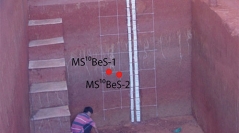

 Comptes Rendus Palevol
17 (1-2) - Pages 143-151
Comptes Rendus Palevol
17 (1-2) - Pages 143-151The lack of carbonates and fossils in Early Paleolithic open air river terrace sites in Korea makes chronological assessment difficult. Nevertheless, a paleomagnetic study of the thickest section (about 9 m) at Mansu-Ri (Locality IV) revealed only normal polarity, indicating an age younger than 0.78 Ma all along the section. In Mansu-Ri (Loc. IV), measurements of the in situ-produced 10Be and 26Al concentrations in two pebbles yield similar 26Al/10Be burial durations ranging from a minimum duration of 225 ka to a maximum duration of 621 ka. In Wondang-Jangnamgyo, two pebbles yield different 26Al/10Be burial durations with a minimum duration of 235 ka and a maximum duration of 495 ka for one and ranging from 975 ka to 3.2 Ma for the other. This last unrealistically old burial duration range most likely results from a complex history of successive burials and expositions. Interestingly, by analogy with the Chinese loess section, the obtained minimum burial durations are coherent with the paleomagnetism result interpretation associating to glacial cycles the 3 paleosoils covering the samples dated at Mansu-Ri.
Early Paleolithic, South Korea, Cosmogenic nuclides, Burial ages